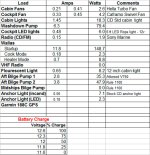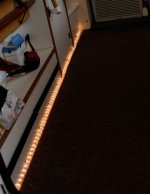You are using an out of date browser. It may not display this or other websites correctly.
You should upgrade or use an alternative browser.
You should upgrade or use an alternative browser.
LED Rope Floor Lighting
- Thread starter RichardW
- Start date
20dauntless
New member
That looks very nice. Someone on the Boston Whaler forum put this same type of light under the gunnel on their boat and it looked great, just another idea. Here is a photo http://img61.imageshack.us/img61/1304/0 ... 0030my.jpg
Hello Dauntless,
Thanks for the input, that Whaler lighting does look good.
Here is how we used green led rope lighting in the cockpit under each gunnel and over the door. We keep one rope in the cockpit on at night they use so little power.

There are a few more photos of the cockpit lighing and mods in the C Eagle album.
Thanks for the input, that Whaler lighting does look good.
Here is how we used green led rope lighting in the cockpit under each gunnel and over the door. We keep one rope in the cockpit on at night they use so little power.

There are a few more photos of the cockpit lighing and mods in the C Eagle album.
Sleepy,
The led rope lights are in 6 ft lengths and draw only .5A so they are very light loads on the batteries. They are 12V so that no inverter is needed. I bought ours at noveltylights.com but there are several available vendors.
These can be bought in many different lengths and colors.
Here is a power consumption table from my album showing current drawn from several typical loads that might be used on a boat.

Richard
The led rope lights are in 6 ft lengths and draw only .5A so they are very light loads on the batteries. They are 12V so that no inverter is needed. I bought ours at noveltylights.com but there are several available vendors.
These can be bought in many different lengths and colors.
Here is a power consumption table from my album showing current drawn from several typical loads that might be used on a boat.

Richard
Nice chart Richard! Good point also made which may be missed on the battery drain % numbers and how those tenths mean much in battery drain. Cool.
I like the lights too. Man, you get Rick and Donna on board on St. Patrick's day and yall will have your own show!! :beer
Got me a new project boat in last week. Need to come down your way and get on your boat again.
Byrdman
I like the lights too. Man, you get Rick and Donna on board on St. Patrick's day and yall will have your own show!! :beer
Got me a new project boat in last week. Need to come down your way and get on your boat again.
Byrdman
A comment about LED colored lights. I have been in several situations where the colored rope lights on a vessel have made it very difficult to visualize the proper red and green navigation lights. The colored lights are fine at a dock, but underway, or even at anchor, if they can be seen by a boat underway, they can cause confusion to other boats. We had the white lights under a hard top on a 42 foot Symbol we owned and these made excellent mood lighting and were usually used at the dock.
The other is about battery voltage. The table given above is relevent for batteries which have been sitting for at least 3 hours--better for overnight rest, with no charge or dischare. The general experience is that higher voltages represent real life use on boats--where various systems (lights, waterpumps, refigeration, nav instruments etc) are in regular use. For realistic battery management I find that following voltages will serve you better in the long run, and what we have used on all of our cruising boats, including where we were dependant on large banks to run all of the boat systems with only charging once a day.
State of Charge Specific Gravity Voltage
12V
100% 1.265 12.7
*75% 1.225 12.4
50% 1.190 12.2
25% 1.155 12.0
Discharged 1.120 11.9
The problem is that sulfation of Batteries starts when specific gravity falls below 1.225 or voltage measures less than 12.4. Sulfation hardens the battery plates reducing and eventually the capacity, and eventually leading to pre-mature death of the battery.
For this reason we never let our batteries go below 12.2 volts, and generally use the battery in the 12.4 volt to 12.7 volt range. In our 2month trip this summer, we never had the battery voltage drop to more than 12.2 volts. This was running refigeration, lights at night and other systems at anchor about 50% of the nights, sometimes for two to 3 days. We size our battery banks to allow us to keep the voltage above 12.2 volts.
The other is about battery voltage. The table given above is relevent for batteries which have been sitting for at least 3 hours--better for overnight rest, with no charge or dischare. The general experience is that higher voltages represent real life use on boats--where various systems (lights, waterpumps, refigeration, nav instruments etc) are in regular use. For realistic battery management I find that following voltages will serve you better in the long run, and what we have used on all of our cruising boats, including where we were dependant on large banks to run all of the boat systems with only charging once a day.
State of Charge Specific Gravity Voltage
12V
100% 1.265 12.7
*75% 1.225 12.4
50% 1.190 12.2
25% 1.155 12.0
Discharged 1.120 11.9
The problem is that sulfation of Batteries starts when specific gravity falls below 1.225 or voltage measures less than 12.4. Sulfation hardens the battery plates reducing and eventually the capacity, and eventually leading to pre-mature death of the battery.
For this reason we never let our batteries go below 12.2 volts, and generally use the battery in the 12.4 volt to 12.7 volt range. In our 2month trip this summer, we never had the battery voltage drop to more than 12.2 volts. This was running refigeration, lights at night and other systems at anchor about 50% of the nights, sometimes for two to 3 days. We size our battery banks to allow us to keep the voltage above 12.2 volts.
Byrdman,
Hope to see you soon; just let me know iwhenever you want to come for a visit.
Dr.Bob,
Thanks for the comments and observations. We only use the overhead rope lights on the cockpit when docked. The under gunnel lights cannot be seen under our camperback and even those are only used when docked. I assumed that the members of this forum have better sense than to operate green or red lights when underway or at anchor where they might be mistaken for navigation lights.
We will talk some day on battery voltages and why I don't use 6 decimal arithmetic to set tight values on battery voltages since these values are dependent upon so many parameters. I never purposely let my battery banks drop below a nominal 12.4V.
Hope to see you soon; just let me know iwhenever you want to come for a visit.
Dr.Bob,
Thanks for the comments and observations. We only use the overhead rope lights on the cockpit when docked. The under gunnel lights cannot be seen under our camperback and even those are only used when docked. I assumed that the members of this forum have better sense than to operate green or red lights when underway or at anchor where they might be mistaken for navigation lights.
We will talk some day on battery voltages and why I don't use 6 decimal arithmetic to set tight values on battery voltages since these values are dependent upon so many parameters. I never purposely let my battery banks drop below a nominal 12.4V.
Hopefully members of the forum have better sense--but I have seen professionally operated boats with these lights, so you never know.
I am glad we agree that 12.4 volts is a desirable "low" voltage for operation. The fear I have is when I see a table with 50% discharge is 12.0 volts--that people will regularly discharge their batteries to this level. We have many new boaters who do not know that this may markedly decrease the life of the battery. Unfortunately many of the boats come from the dealer with smaller battery banks than ideal, especially with refigeration. Thanks for the comments--and I am well aware of the multiple problems with battery voltage. I use both amp meters and digital volt meters to moniter my batteries and it has served me well for many thousands miles at sea.
I am glad we agree that 12.4 volts is a desirable "low" voltage for operation. The fear I have is when I see a table with 50% discharge is 12.0 volts--that people will regularly discharge their batteries to this level. We have many new boaters who do not know that this may markedly decrease the life of the battery. Unfortunately many of the boats come from the dealer with smaller battery banks than ideal, especially with refigeration. Thanks for the comments--and I am well aware of the multiple problems with battery voltage. I use both amp meters and digital volt meters to moniter my batteries and it has served me well for many thousands miles at sea.
Hey Bob & Richard.... Now, man...I know how exciting that in depth, in the weeds chat about voltage will be..... and for some reason...I am having flash backs of chemistry class....and the same thing just happened.... my mind drifted back to being out on my boat.
I just got to settle for the fact that when I hit the 12.5 to 12.4 range...no matter what got it there, or how long it has been there.... I need to get some juice going back into the batteries. OK...juice is more than likely the term yall would use in this conversation.
You guys should come out onto the Cumberland River for one of our buoy patrols.... if ya want to see some very interesting light shows. We just have to take it for what it could be....in that if it has lights...it is man made, and then, do not hit it. From there.... no telling what will happen.
Les was on my boat one night when a Thursday night Bass tourney dock time of 1030pm ends the gig....and if you are not there by then...your fish do not count. There is a long channel, about 2 miles long...and a very wide 100' width for about 1.5 miles of that 2 mile stretch... Forget what laws are, and how folks should act on the water....just get out of the way from about 1005 to 1040.....cause most things moving on the water are going to that dock, fast...about 60-85mph range....dot-to-dot on a GPS.... Kinda fun to watch actually set back in a little hidden spot... with what ever color lights show up on the boat. Grin.
I do not know why I have always wanted to blow up one of those yard snow man and float it out there just to see what they would do... ?? :embarrased
Cool Lights Richard.... Hope to see all yall soon.
Byrdman
I just got to settle for the fact that when I hit the 12.5 to 12.4 range...no matter what got it there, or how long it has been there.... I need to get some juice going back into the batteries. OK...juice is more than likely the term yall would use in this conversation.
You guys should come out onto the Cumberland River for one of our buoy patrols.... if ya want to see some very interesting light shows. We just have to take it for what it could be....in that if it has lights...it is man made, and then, do not hit it. From there.... no telling what will happen.
Les was on my boat one night when a Thursday night Bass tourney dock time of 1030pm ends the gig....and if you are not there by then...your fish do not count. There is a long channel, about 2 miles long...and a very wide 100' width for about 1.5 miles of that 2 mile stretch... Forget what laws are, and how folks should act on the water....just get out of the way from about 1005 to 1040.....cause most things moving on the water are going to that dock, fast...about 60-85mph range....dot-to-dot on a GPS.... Kinda fun to watch actually set back in a little hidden spot... with what ever color lights show up on the boat. Grin.
I do not know why I have always wanted to blow up one of those yard snow man and float it out there just to see what they would do... ?? :embarrased
Cool Lights Richard.... Hope to see all yall soon.
Byrdman

